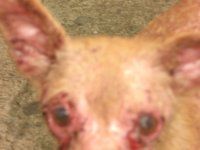Skin Care: Chemicals and Synthetics
Sponsored Links
Here's a list of chemicals and synthetics you should avoid that are commonly found in skin care products, cosmetics and even food.
The following list is provided to help give you some extra information and knowledge about 44 toxic ingredients used in personal care products.
The shocking fact though is that this is only 44 of the over 800 toxic ingredients that exist!
The other shocking fact is that some of these ingredients are also used in pet food and human food — including the all popular salad dressings.
The bonus scary thought is that some of these ingredients are also used in skin care products by companies who market themselves as natural... especially one worldwide famous company.
- AHA (alpha hydroxy acid)
Skin is exfoliated chemically instead of mechanically via abrasion, dries the skin and increases aging. Supposed to be anti–wrinkle, found in many skin and hair care products. Used as a solvent originally in cleaning compounds and for tanning leather. A smooth finish is developed by stripping the outer layer of the skin, irritated skin can puff up.
- Acetamide MEA
Used in lipstick and cream blusher to retain moisture. Causes adverse reactions, carcinogenic, mutagenic and toxic.
- Alkyl–phenol–ethoxylades
Mimics estrogen. Used in shampoos. It is carcinogenic, mutagenic and toxic. Causes adverse reactions. Reduces sperm count.
- Ammonium laureth sulphate
Found in hair and bubble bath products. Laureth contains either that is listed as carcinogenic, mutagenic, toxic and causes adverse reactions.
- Aluminum
Used as colour additive in cosmetics, especially eye shadow. Listed as carcinogenic, toxic and mutagenic.
- Alcohol
Acts as a carrying and antifoaming agent. Fast drying, water and oil solvent. If synthetically produced is carcinogenic, mutagenic, toxic and causes adverse reactions.
- Bentonite
Used in facial mask, make–up, face powder. Supposed to draw out toxins and claimed to be non–toxic, but rats died when injected with it.
- Benzene
Found combined with other chemicals in many personal care product and is a known bone marrow poison. Carcinogenic, mutagenic, toxic and causes adverse reactions.
- Coal Tar
Many kinds of shampoos designed to treat dandruff and flaky scalp contain it. Disguised with names like FD, FDC, or FD&C colour. Coal tar causes potentially severe allergic reactions, asthma attacks, fatigue, nervousness, headaches, nausea, lack of concentration and cancer.
- Cocamide DEA
Nitrosamines can form in all cosmetic ingredients containing amines and amino derivatives with nitrogen compounds. When DEA is applied to the skin then known carcinogens can form.
- Cocomide DEA
Mostly found in shampoos. Contains nitrosamines that are known carcinogens causing allergic reactions and contact dermatitis.
- Cocomidopropyl Betaine
Used in shampoo in combination with other surfactants. Synthetic. Causes eyelid dermatitis.
- Carbomer 934, 940, 941, 960, 961 C
As thickener, stabilizer in creams, toothpaste, eye makeup, bathing products. May cause eye irritation.
- DEA (diethanolamine)
A synthetic solvent, detergent and humectant widely used in brake fluid, industrial degreasers and antifreeze. Mostly used in liquid soap, shampoo and conditioner. Can be harmful for the liver, kidneys and pancreas. May cause cancer in various organs. Irritates skin, eyes, mucous membranes. Found also in hair dye, lotions, creams, bubble bath, liquid dishwashing detergent and laundry soap Health risk especially to infants and young children. Forms nitrosamines known to be carcinogens. Causes allergic reactions and other contact dermatitis. Hazardous and toxic.
- Dimethylamine
Secondary amines cause allergic dermatitis. Carcinogenic properties.
- Dioform
Many toothpaste and other tooth whiteners contain it. Damages your teeth enamel weakening their protective shell.
- Disodium EDTA
May contain dangerous levels of ethylene oxide and/or dixane, both potent toxins. A manufacturing byproduct. Also used as chelating agent. Carcinogenic.
- Hydantoin DMDM
Causes dermatitis. Acts as a preservative and may release formaldehyde and is a suspected carcinogen. Rats develop cancer when injected with this chemical.
- Elastin
Supposed to improve the elasticity of the skin when applied externally, however, there is no proof.
- FDC–n (FD&C)
Various different colours. Some are simply irritant while others are strong carcinogens.
- Fluoride
Hazardous chemical. Researchers linked it to cancer years ago. No one is listening. Fluoridated toothpaste is especially dangerous to young children who tend to swallow it after brushing their teeth. Supposed to stop tooth decay. Scientists are now linking fluoride to dental deformity, arthritis, allergic reactions, can lead to Crohn's disease. A manufacturing toxic by–product.
- Formaldehyde
Due to its bad name it is sometimes hidden under the name DMDM hydantoin or MDM hydantion. Trade name if Formalin which is also used in vaccines. Released by diazolidinyl urea. Causes dermatitis, adverse effects, is very toxic when swallowed or inhaled, skin irritant, very toxic, a suspected carcinogen and linked to cancer.
- Glycols (group)
Causes delay contact allergy. Used as humectant (emulsifier/moisturizer). In most cases as a cheap glycerin substitute. Propylene glycol did case liver abnormalities and kidney damage in laboratory animals. Diethylene glycol and carbitol are considered toxic. Ethylene glycol is a suspected bladder carcinogen. Glycols are carcinogenic, mutagenic, toxic and cause adverse reactions.
- Imidazolidinyl Urea
Causes dermatitis. If heated to higher temperatures it produces formaldehyde.
- Lauramide DEA
Nitrosomines can form in all cosmetic ingredients containing amines and amino acid derivatives. with nitrogen compounds and nitrosamines and known carcinogens.
- Methyl Chloroisothiazolinine
Carcinogenic, mutagenic, toxic and cases adverse reactions.
- Paba (p–aminobenzoic acid)
Causes photo sensitivity and contact dermatitis. A common sunscreen ingredient.
- Parabens
Trademark for butyl, ethyl, germa, methyl, propyl paraben. Causes dermatitis. Used as a preservative in a variety of personal care products especially cream and lotion. Allergic reactions. Petroleum based.
- PEG (4–200)
Abbreviation for polyethylene glycol, polyoxethylene, polyglycol, polyether glycol. A manufacturing by–product. Dangerous levels of the toxin dioxane has been found in this product.
- Phosphoric Acid
As an inorganic phosphate acid it is very disruptive to the skin if used in high concentrations.
- Phenoxyethanol
Causes allergic reactions.
- Polysorbate (20–85)
Causes contact sensitivity and irritation.
- Polyquaternium
Followed by any number they are carcinogenic, mutagenic, toxic and causes adverse reactions. Induced contact dermatitis, causes fatal drug allergy (anaphylactic shock), may cause increased sensitivity to muscle relaxants.
- Propylene Glycol
Found in most shampoo and conditioner. Derived from petroleum products. Also used in anti–freeze, de–icer, latex, paint, and laundry detergent. Can cause irritation of nasal and respiratory passages and if ingested, can cause nausea, vomitting and diarrhea. Research also shows it is mutagenic, causes cardiac arrest. Japanese studies also show it damages cell DNA (genetic code). Strongly degreases and dries skin.
- Sodium Laureth Sulfate
Causes skin irritation and dermatitis. Used mainly in shampoo and conditioners. Has ether added and is toxic.
- Sodium Lauryl Sulfate
An ingredient used in 90% of commercially available shampoo and conditioners. Corrodes hair follicles and impedes hair growth. If found in car wash soap, engine degreasers, toothpaste, cream, lotion, and garage floor cleaners. Penetrates your eyes, brain, lover and remains there for long term. Degenerates cell membranes and can change the genetic information (mutagenic) in cells and damages the immune system. May cause blindness and lead to cataracts. Eyes cannot heal properly. Retards the healing process.
- Sodium Cyanide
Carcinogenic, mutagenic, toxic, and causes adverse reactions.
- Sodium Oleth Sulfate
May contain dangerous levels of ethylene oxide and/or dioxane, both potent toxins.
- Sodium PCA (NAPCA)
Conditioner for skin and hair, synthetic version can seriously dry the skin and cause allergic reactions.
- Styrene Monomer
Carcinogenic, mutagenic, toxic and causes adverse reactions.
- Stearamidopropyl Tetrasodium EDTA
Nitrosomines can form in all cosmetic ingredients containing amines and amino acid derivatives. with nitrogen compounds and nitrosamines and known carcinogens.
- Talc
Hazardous. Toxic by inhalation. Some talc found to contain amphibole particle distribution typical to asbestos (which is cancer causing).
- Toluene
Used as a solvent in cosmetics, especially nail polish and dyes. Also in pharmaceuticals and gasoline as a blending agent.
- Triethanolamine (TEA)
Causes severe facial dermatitis, irritation and sensitivity. Used as pH adjuster. Reacts with stearic acid to form oil in water emulsions (typically lotions). May contain nitrosamines, known carcinogens.
Descriptive Words
- Carcinogen (carcinogenic): known to be cancer causing.
- Humectant: a product which helps the skin retain moisture — vegetable glycerin is a humectant.
- Mutagenic: changes the genetic code which are the building blocks of cells.
- Toxic: poisonous, either short term or long term.
Suggested Reading
- Beauty To Die For by Judie Vance
- Natural Organic Hair and Skin Care by Aubrex Hampton
- Creating Your Own Cosmetic — Naturally by Niklaus J. Smeth
- Don't Go To The Cosmetic Counter Without Me by Paula Begound
- Your Natural Health Makeover by Dr. Lauri Aesoph
Gone To The Dogs
Yes, skin care has, in fact, gone to the dogs!
- Thoughts About Detoxification
- Aiding Detoxification
- Review Of Detoxification
- Taurine and Other Benefits of Raw Meat
- Information About Vegetables
- Information About Fruits
- Pet Supplements I Use
- Essential Fatty Acids
- Dog and Cat Flea Problems
- Minor Cuts and Sores
- Natural Antibiotics
- Skin and Coat Problems
- Teething Puppy
- Glandular Therapy
- Pet Allergies
- Signs Our Pets May Not Be 100% Healthy
- Thought About Health Concerns
- Frequently Asked Questions
- Homeopathic First Aid
- Diabetes and Pets
- Poison — What Can Poison Our Pets
- Pets With Cancer
- Dangers of Vaccinations
- Skin Care: Chemicals and Synthetics
- Skin Care For Pets — Shampoos and Oils
- Herbs For The Skin and Body
- Summary of Homemade Pet Food
 Meet Jumbo, the participant in
Meet Jumbo, the participant in 